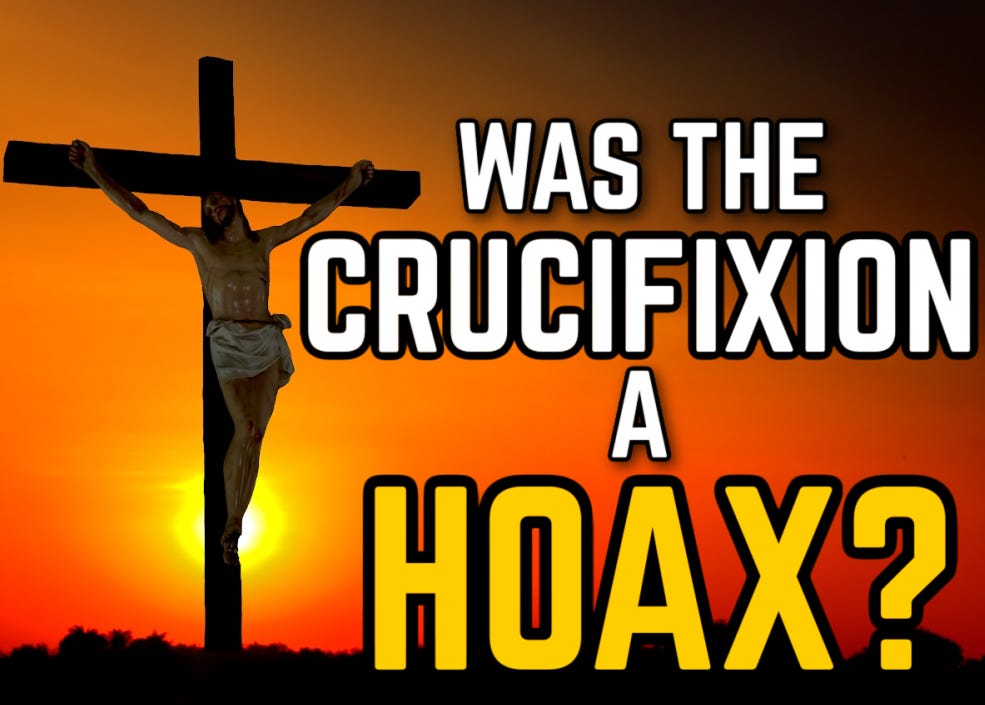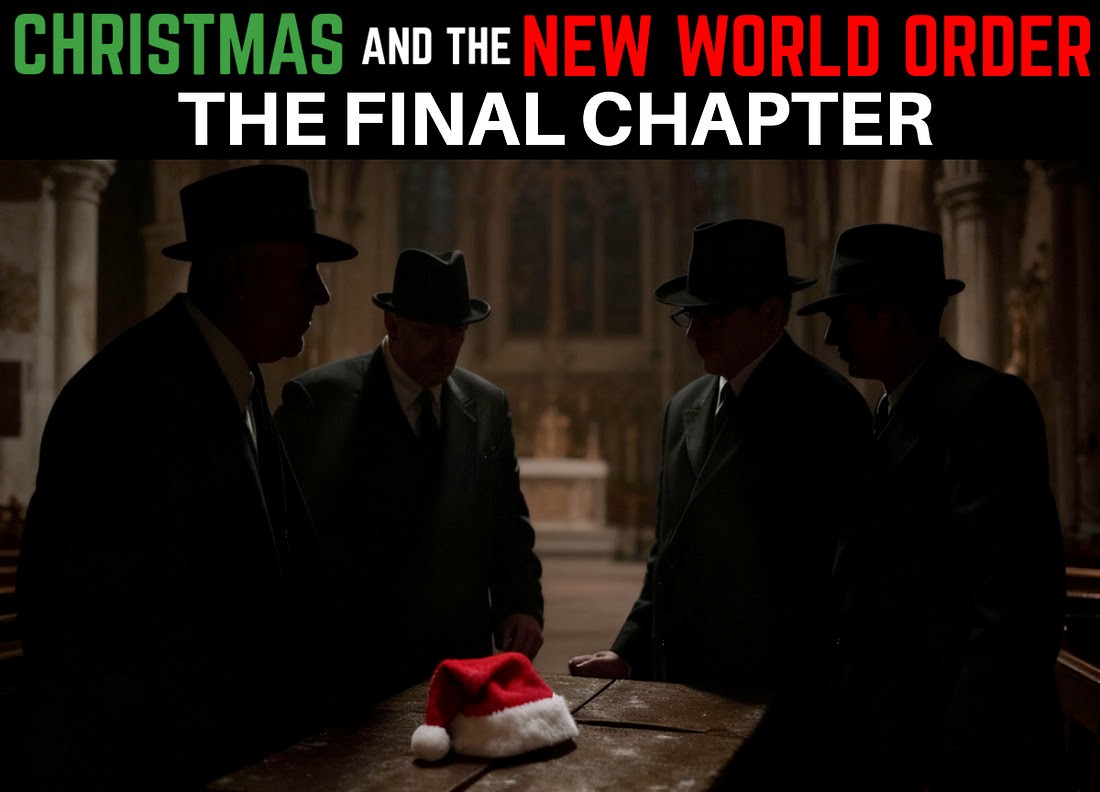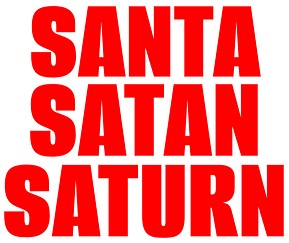

If you type “Christmas” into the search box and click on images, this is what you get:
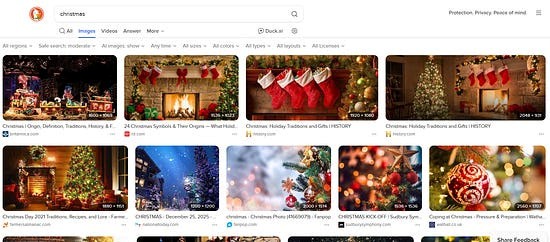
Google:

Microsoft Edge:
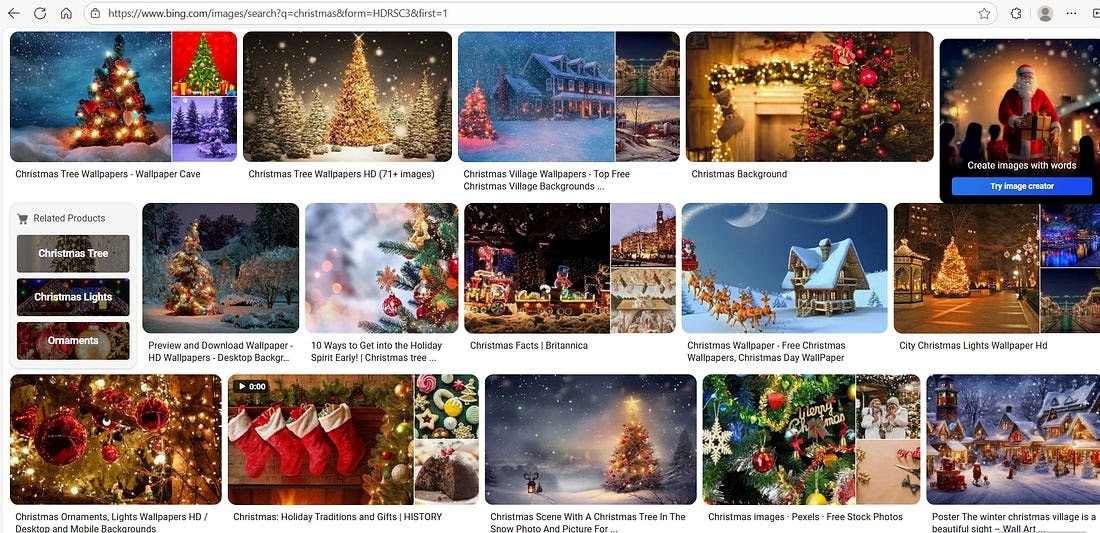
So when I say “Christmas”, I am referring to what is shown in the images above: a decorated tree with a pile of presents under it, Santa, reindeer, and stockings stuffed with more presents, okay? Now that we have a definition of “Christmas”, let’s get the basics out of the way:
Would you believe it if I told you Christmas in the United States and Britain is a new thing? Right about now, you’re probably thinking this sounds ridiculous: of course, Christmas has been around forever! That’s what I also thought, but the research shows otherwise.
The English government didn’t recognize Christmas as a holiday until 1834! But even then, Scotland didn’t declare it as such, and there was no such thing in America.
Upon learning this, I knew where the real story would lie: Who created what we now call Christmas in America?
MEET THE HOLIDAY MAKERS
Surprisingly, there were only a few key players in the Christmas plot, but as we saw in my series, the Never Before Told Story of the Illuminati and the Takeover of America, a few men can move mountains because they are put into a couple dozen important roles. Anytime you see these guys who go from one high-up position to the next in completely different industries, you can safely assume they’re part of the cabal. Nobody in the real world goes from being the head of the school system to being in Congress to becoming the President of a large charity. Whenever you see these people being shifted around, changing jobs every couple of years, and getting positions in fields that have nothing to do with each other, rest assured, they are “in on it”. Now it’s time for you to meet the first creator of “Christmas”:
MR. PINTARD
The American Revolution had just ended, the Illuminati seized control of America, the Constitution that made us all “constitutors” (someone responsible for someone else’s debt) went into effect, and the IlluminatiMasons were installed into positions of power throughout our nation.
In New York in 1789, a man named John Pintard was elected Assistant Alderman of the East (Second) Ward of the city. (An alderman is a member of a municipal assembly or a council in many jurisdictions, so this guy was overseeing multiple areas.) Pintard was also a representative of the state of New York, but that wasn’t all he did. Let me share more bullet points from his resume because it is so ridiculous that you have to chuckle:
He was appointed by New Jersey as one of five commissioners to erect bridges.
Simultaneously, he was appointed secretary of the New-York Manufacturing Society.
Come 1804, Pintard founded the New York Historical Society, which would become one of the arbiters of history.
He also founded the Massachusetts Historical Society.
Pintard drafted the constitution of the corrupt Tammany Society, also known as the Columbian Order.
John pushed for the canonization of Christopher Columbus within
Tammany. (Columbus was a literal terrorist who never once set foot on American soil.)
But that’s not all: Pintard got (Illuminati) Thomas Jefferson to purchase the Louisiana Territory.
He served as the first city inspector of New York City.
He was involved in government loan operations. Are you giggling yet? If not, just wait…
Pintard served as manager of the state lotteries.
In fact, he is the reason the “free” (tax-funded) school system in New York exists.
Even that is not all! John was part of the team that built the Erie Canal
And he was a part of the library of the General Theological Seminary in
New York, not to be confused with The Theosophical Society, also in
New York, which was an esoteric religious movement. Actually, maybe they should be confused because, at one point in time, the Theological Seminary instructor built an altar inside Southern Methodist University so students could worship the Roman mythological goddess Diana. Worshipping included sacrificial offerings. And yes, the altar was indeed installed into a college.
You would think with all these jobs, Johnny wouldn’t have time for any further activities, but that’s just not true. What history doesn’t tell us about John is that he was also a holiday maker. It was Johnny-boy’s idea to make George Washington’s (aka Jupiter Baphomet’s) birthday, and the Fourth of July, federal holidays. A few years later, Mr. Pintard was firing up a new holiday.
This time around, he had an idea, but his idea wasn’t fully developed.
What John came up with was a character called Sinter Claes. This was a concept derived from an old character, Sinterklaas, a Greek bishop of Myra (present-day Turkey). The Greek bishop version “is depicted as an elderly, stately, and serious man with white hair and a long, full beard. He wears a long red cape over a traditional white bishop’s alb and a sometimes-red stole”. He also dons a red mitre and ruby ring. The Greek Bishop holds a gold-colored shepherd’s staff with a fancy curled top.
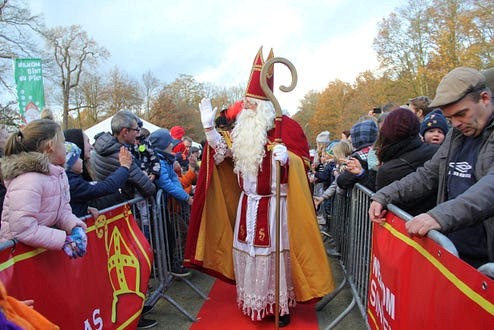
Around the 16th century, Sinterklaas began being celebrated in early December in the Dutch Empire, Germany, and a few other places.
John created his Sinter Claes as a man wearing a druid priest robe and carrying a wand. At some point in time, Pintard would rename his new character “Saint Nicholas”.

Here is a druid priest robe for comparison.
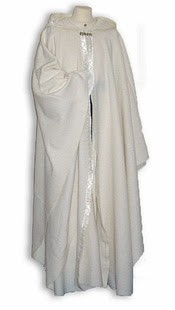
So the guy who first got the ball rolling on what we currently call Christmas was deep in the government and tied to the worship of Roman mythological gods.
Not much happened in America with Pintard’s new character. There was still no such thing as Christmas here, but in the 1830s across the pond, the English media was beginning to promote the idea of a Christmas holiday.
Four years from now, England would declare it a legal holiday.
MR. MOORE
The next character in the Christmas Plot was Mr. Clement Moore, whose father was tied to (Illuminati) Alexander Hamilton. Moore’s brother was a professor of Hebrew in New York while Moore himself wrote the Hebrew dictionary. Although Moore is historically given credit for the hit, The Night
Before Christmas, researchers and scholars alike believe he is not actually its author. Regardless of who wrote it, the poem first appeared in the New York news, and not long after, it was made mandatory reading for kids in schools.
This poetry-style story, a Night Before Christmas (originally titled A Visit from Saint Nicholas) is what painted the image we all have of Santa and what we call Christmas today. If you need a refresher, here you go:
_________________________________
‘’Twas the night before Christmas, when all through the house
Not a creature was stirring, not even a mouse;
The stockings were hung by the chimney with care,
In hopes that St. Nicholas soon would be there;
The children were nestled all snug in their beds,
While visions of sugar-plums danced in their heads;
And mamma in her ’kerchief, and I in my cap,
Had just settled our brains for a long winter’s nap, When out on the lawn there arose such a clatter,
I sprang from the bed to see what was the matter.
Away to the window I flew like a flash,
Tore open the shutters and threw up the sash.
The moon on the breast of the new-fallen snow
Gave the lustre of mid-day to objects below,
When, what to my wondering eyes should appear,
But a miniature sleigh, and eight tiny reindeer,
With a little old driver, so lively and quick, I knew in a moment it must be St. Nick.
More rapid than eagles his coursers they came,
And he whistled, and shouted, and called them by name;
“Now, Dasher! now, Dancer! now, Prancer and Vixen!
On, Comet! on, Cupid! on, Donder and Blitzen!
To the top of the porch! to the top of the wall!
Now dash away! dash away! dash away all!”
As dry leaves that before the wild hurricane fly,
When they meet with an obstacle, mount to the sky;
So up to the house-top the coursers they flew,
With the sleigh full of Toys, and St. Nicholas too.
And then, in a twinkling, I heard on the roof
The prancing and pawing of each little hoof.
As I drew in my head, and was turning around,
Down the chimney St. Nicholas came with a bound.
He was dressed all in fur, from his head to his foot,
And his clothes were all tarnished with ashes and soot;
A bundle of Toys he had flung on his back,
And he looked like a pedler just opening his pack.
His eyes—how they twinkled! his dimples how merry!
His cheeks were like roses, his nose like a cherry!
His droll little mouth was drawn up like a bow
And the beard of his chin was as white as the snow;
The stump of a pipe he held tight in his teeth,
And the smoke it encircled his head like a wreath;
He had a broad face and a little round belly,
That shook when he laughed, like a bowlful of jelly.
He was chubby and plump, a right jolly old elf,
And I laughed when I saw him, in spite of myself;
A wink of his eye and a twist of his head,
Soon gave me to know I had nothing to dread;
He spoke not a word, but went straight to his work,
And filled all the stockings; then turned with a jerk,
And laying his finger aside of his nose,
And giving a nod, up the chimney he rose;
He sprang to his sleigh, to his team gave a whistle,
And away they all flew like the down of a thistle,
But I heard him exclaim, ere he drove out of sight,
“Happy Christmas to all, and to all a good-night.”
_________________________________
As you will notice, Moore’s version of Saint Nicholas has no mention of religion, no druid robe, no mitered cap, no wand. What replaced John Pintard’s Sinter Claes was a fat, merry elf. And remind yourself, the man who wrote this poem, or should I say who was given credit for writing the poem, also wrote the Hebrew dictionary.
Meet the next characters in the Christmas plot:
THE QUEEN
King George III’s granddaughter, Queen Victoria put up a Christmas tree in
Windsor Castle (1840s). Illustrated London News then made the tree famous. Keep in mind, at this point in time, nobody had Christmas trees, so bringing a tree indoors was not commonplace in Britain or America.
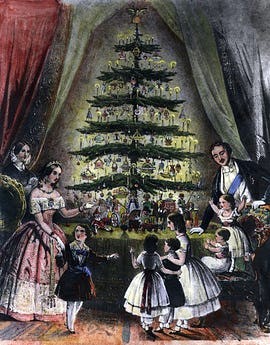
Due to the media, the tree wasn’t the only trend set by the Queen. She was also responsible for white wedding dresses (yet another thing we assume has been around forever but hasn’t). Keep in mind, her father, King George III’s son, was super high up in Freemasonry.
Next up:
MR. DICKENS
The next player on our list is Charles Dickens. It is important to note, Charles, whose nickname was Moses, was a government employee who worked in the House of Commons (Parliament). He began reporting on Parliamentary debates and traveling across Britain to cover election campaigns for the
Morning Chronicle newspaper. Dickens was also an early member of The Ghost Club of London, specializing in the study of paranormal activities.
Researchers claim the Ghost Club itself was actually organized as a front for
British intelligence operations. The members’ list includes Julian Huxley
(United Nations UNESCO founder), Sherlock Holmes author Arthur Conan
Doyle, and Lord Dowding, who was the senior officer in the Royal Air Force.
Charles, aka Moses, struck up a friendship with William Harrison Ainsworth. That guy was the author of a popular novel called Rookwood. Harrison threw private social events aimed at introducing men to each other: the original “social network”. Think of it like a Freemasonic lodge without having to join the brotherhood, or like Facebook but only with the influencers of society. These events became regular meeting spots for men involved with all aspects of the media: from books to newspapers to art and theater, even government employees, all of these men would gather to socialize. It appears all were involved in politics in one way or another. In fact, one of the men who frequented the closed-door events thrown by Harrison was Jewish Benjamin Disraeli, Prime Minister of the United Kingdom. These events gave Dickens a wealth of connections.
History claims, in England, 1843, Charles Dickens hastily threw together his masterpiece, A Christmas Carol, then went on tour reading it. Although Christmas had only been a holiday in Britain for a decade, the story itself was a hit. With the help of the papers, Dickens and his novel became famous overnight, and this is quite fascinating because of the story itself.
Recall that the tale focuses on Ebenezer Scrooge, a cold-hearted man who refuses to spend money and despises Christmas; “Bah! Humbug!“ His redemption came through visits from the ghost of Jacob Marley and the Ghosts of Christmas Past, Present, and Yet to Come. The Ghost of Christmas Yet to Come showed Scrooge where his greed and selfishness would lead: a lonely death and a neglected grave. Scrooge then promised to change his greedy ways. Embodied with the “Christmas Spirit”, Scrooge set out to become a good, caring, gifting, and Christmas-enjoying individual.
This novel laid the foundation for what would become a universally held societal opinion; people who do not celebrate Christmas are a “Scrooge” and nobody wants to be a Scrooge, therefore everybody must celebrate.
I should probably mention, Ebenezer is a Jewish name of Hebrew origin. Is it of interest that the man who doesn’t celebrate Christmas, the villain per se, has a Jewish name when Jews also do not celebrate Christmas? It’s as if it were foreshadowing what was to come.
Dickens’ book was also made mandatory reading material in schools, and he began cranking out Christmas novels.
Now we head back to America:
In the United States, states began declaring Christmas a holiday. Between 1845 – 1849, Connecticut, Pennsylvania, New York, and Virginia became the first to recognize the day. Citizens, however, still went to work.
Even though we are assured this holiday is to celebrate baby Jesus, as of 1855, most churches did not accept the day as anything special and were closed. Being that history now tells us December 25th was declared to be Jesus’ birthday around the year 200 and made official by the Pope around the year 400, it is baffling why, nearly 1,500 years later, Christian churches did not celebrate it. If that doesn’t make you curious as to what is actually going on here, what does?
JP MORGAN
Well, technically, it wasn’t JP himself, it was his uncle, John Pierpont. Uncle Pierpont was said to have written “Jingle Bells” which, once again, became an overnight sensation. Next up…
MR. NAST
According to Wikipedia, the Bavarian government was “at odds” with Nast’s father over “politics” (it sounds like his father was an insurrectionist / Communist revolutionary, but I have no proof of this). Because of the fallout with the government, his son, Thomas Nast, was sent to New York and arrived in 1846. Thomas was quickly put into the media and worked as an illustrator for the magazine Harper’s Weekly. Nast enjoyed creating political cartoons that portrayed Lincoln as a beloved politician. He also drew frequent anti-Catholic cartoons and “expressed anti-Irish sentiment by depicting them as violent drunks. He used Irish people as a symbol of mob violence…”
Catholics and the Irish were not Nast’s only targets. He promoted racism by stereotyping black people as being comparable to the awful Irish. Other than Mr. Lincoln, Nast happened to be quite fond of the Chinese. The word “nasty“ is thought to be derived from Nast’s name, due to the “cynical tone” of many of his cartoons, but scholars argue this likely isn’t true.
Nast would go on to make famous the Republican Party elephant,
Democratic Party donkey, and the American icon “Uncle Sam”. Just like Mr.
Pintard, this man involved with politics suddenly became involved with this new thing called “Christmas”. Nast published Thomas Nast’s Christmas Drawings for the Human Race.
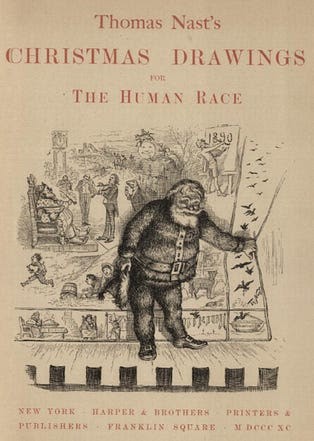
It was this publication that created the character who we know today as Santa Claus.
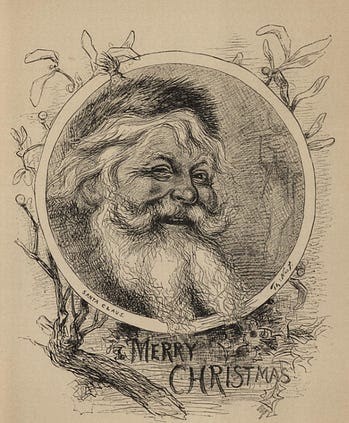
He also created the story line for Santa including the concept of Santa getting mail.
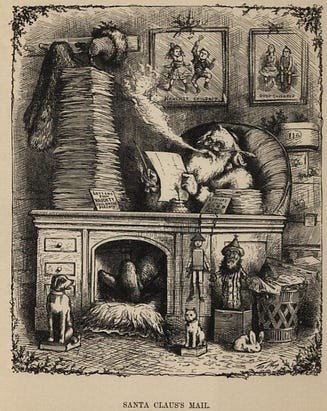
And the idea that Santa went down chimneys.
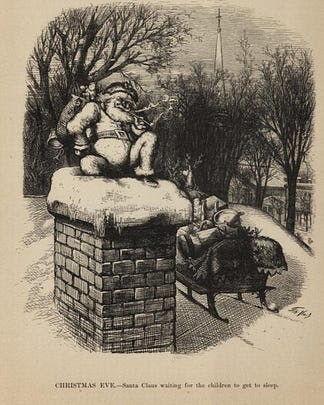

He gave him a home at the North Pole.
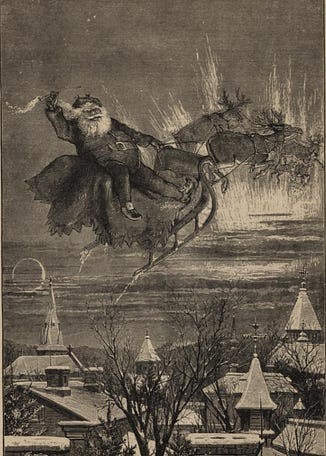
And made him a beloved character.
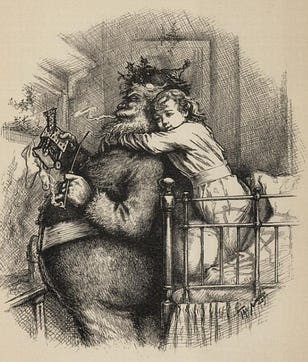
What’s interesting is, Nast’s Santa is also another character of Nast’s… Bacchus.
Bacchus is the Roman god of wine, revelry, uninhibited celebrations (orgies), theater, and madness. “Bacchus’s mythology serves as a reminder of the thin line between ecstasy and madness, illustrating how the pursuit of pleasure can lead to both enlightenment and destruction.” Here’s Thomas Nast’s illustration in which “King Death” pins a medal on Bacchus for spreading so much evil and destruction.
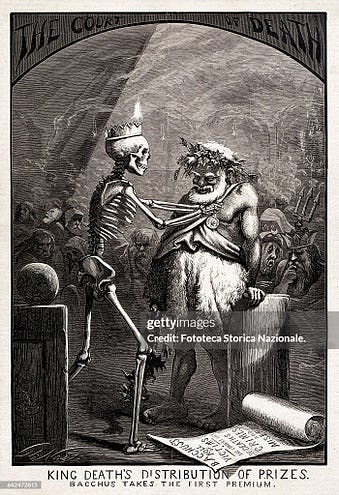
You can clearly see that his depiction of Bacchus is nearly identical to his depiction of Santa.
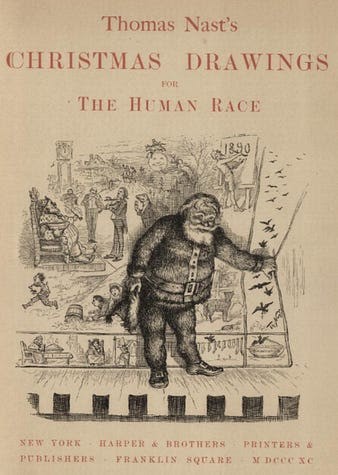
Instead of a crown of laurel leaves, Nast gave Santa holly leaves.

And this makes a lot of sense if you compare what Santa came to represent: overindulgence in materialism. Could Thomas have known the scheme so far in the future? Is it possible he knew the juggernaut Santa was to become?
Thomas Nast’s influence on society through art would become so widespread that Freemason President Theodore Roosevelt once said, “Thomas Nast was our best teacher.”
THE CHRISTMAS PSYOP
As of the 1860s, Santa began to appear as a cartoon in Harper’s Weekly regularly.
Despite churches still being closed, by this time, everyone had a tree in their living room to be like the Queen and their favorite celebrities, but it would be another decade before Congress agreed to make it a federal holiday. Yep, it’s true! Up until Congress voted to observe it in 1870, there was no official Christmas holiday in the United States!
Now we must ask, how do we all believe this holiday is a part of America that has been around since the beginning of time, when people didn’t have trees until around 1860, and it wasn’t an official holiday until 1870? Surprisingly there is an answer to this question.
From the time Dickens’ novel was published, Christmas was given artificial nostalgia. 20 years after Congress approved Christmas, President Benjamin Harrison put the first tree in the white house. It was described as an “oldfashioned Christmas tree for the grandchildren”. Yeah, the first tree ever in the White House was labeled “old-fashioned”. Through fictitious stories in children’s books, and poems and tales published in the papers, we were led to believe Christmas was a pillar of our country and something that has been a part of culture since ancient times.
THE LETTER
It was now almost the year 1900, and it was time to kick the Christmas psyop into overdrive. In 1897, the editors of the New York Sun claimed to have received an “unusual letter” from a child named Virginia O’Hanlon. The letter reads as follows:
“Dear Editor:
I am eight years old. Some of my little friends say there is no Santa Claus. Papa says, “If you see it in The Sun it’s so.” Please tell me the truth, is there a Santa Claus?”
(I don’t know a single child who refers to their friends as “my little friends”, but let’s roll with it.)
Francis Church, one of the Sun newspaper’s editors, drafted the reply and published it in the paper. I will extract parts of the reply; you can read the full thing in the screenshot below.
“Virginia, your little friends are wrong. They have been affected by the skepticism of a skeptical age.” Church argued that just because something could not be seen did not mean it was not real: “Nobody can conceive or imagine all the wonders there are unseen and unseeable in the world… Thank God! he lives, and he lives forever. A thousand years from now, Virginia, nay, ten times ten thousand years from now, he will continue to make glad the heart of childhood.”
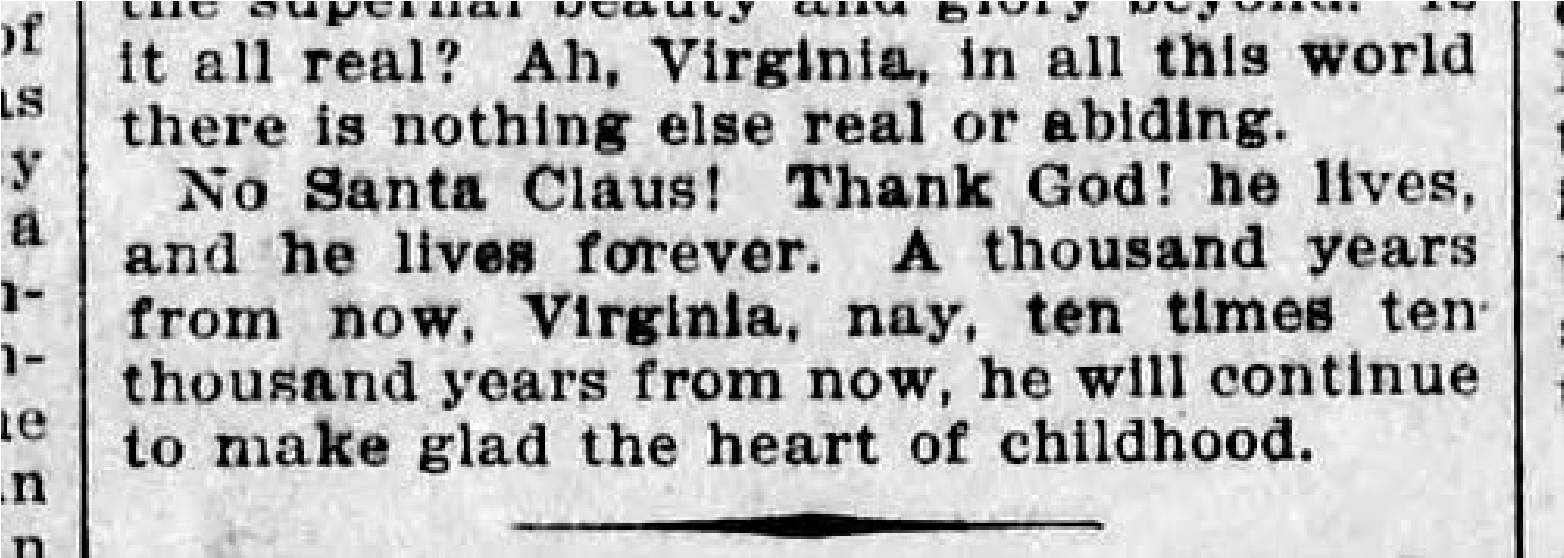
The newspaper letter and reply were published all over America, and it single-handedly opened the door for Santa coming out of the pages of books and into our living rooms.
On the same page of the newspapers as the Virginia question and response, appeared Christmas gift ads.
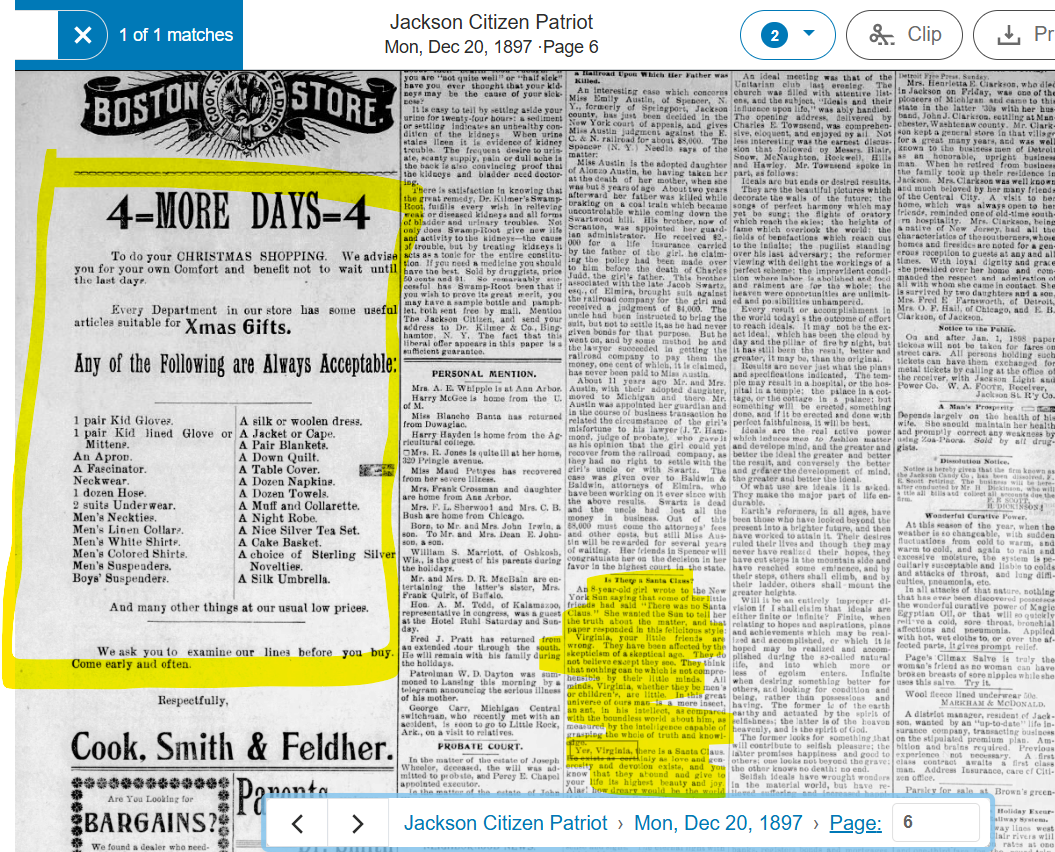
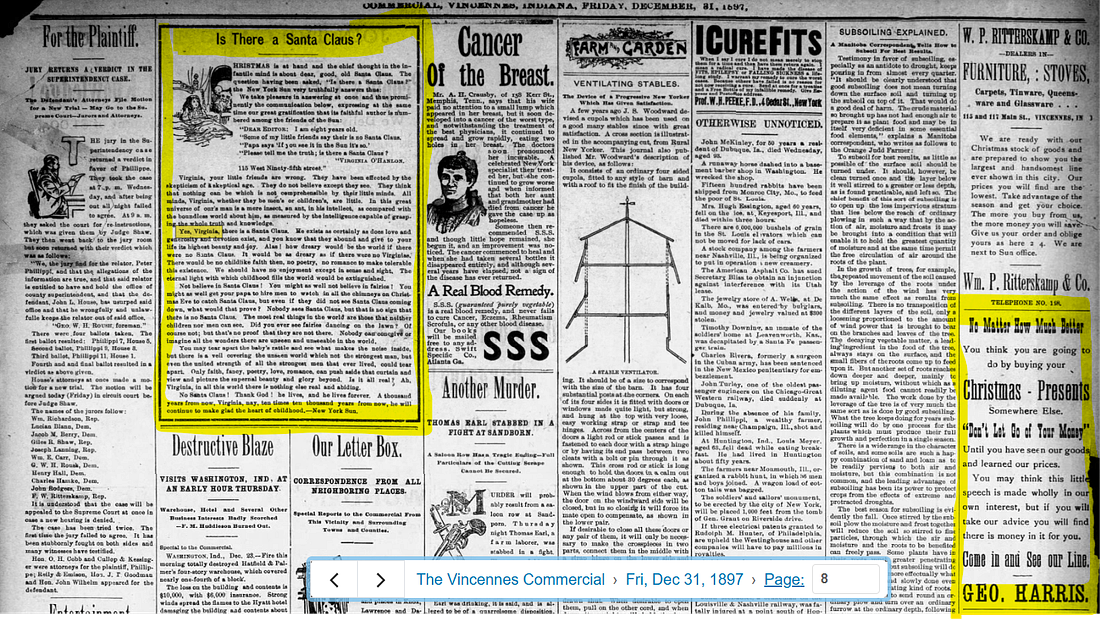
In only a few years, Santa books lined children’s shelves. Tales of the goodhearted, trustworthy, chubby fellow who brings gifts and cheer to the world were everywhere. Writers and artists seized the opportunity to recreate the jolly elf, and before 1900, Mrs. Claus came to be.
Mrs. Claus was invented by Katherine Lee Bates, who happened to be the lyricist for the classic hit “America the Beautiful”.
Come 1901, nearly fifty years after people brought trees into their living room to be like their favorite stars, Ladies’ Home Journal announced that Santa was disgusted with society. He was sickened that people were so selfish, and he was not going to make his rounds this year if people didn’t change. This marked the beginning of Santa exploitation.
Next, the papers ran illustrations of children sneaking out of their bedrooms in the middle of the night to see if Santa had brought them presents, and this is what made Christmas what we know it as. It was as simple as that: children saw the art of their peers spying on Santa leaving presents, they read books about it in school, they knew all about Yes, Virginia, and parents didn’t want to disappoint their children, so everyone played along.
Come 1931, Coca-Cola made the official image of Santa, and everything became “Christmasfied”.
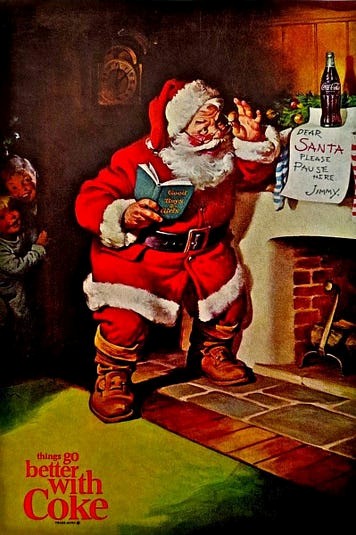
The 1950s were filled with Christmas movies, including A Christmas Carol, White Christmas, Scrooge, and more.
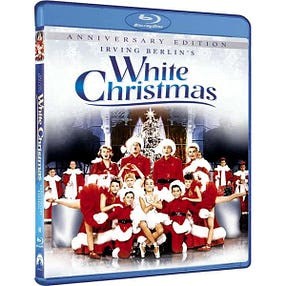
The Vatican issued Christmas stamps (1959).

The US Postal Service (USPS) followed suit and released their own stamps (1962), followed by annual holiday postage releases.
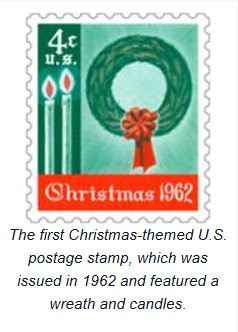
How the Grinch Stole Christmas came out in 1966, further embedding the narrative that those who don’t celebrate the new holiday were terrible people with no heart. Now you are both a Scrooge and a Grinch if you don’t partake. This wasn’t the only hit of the decade. Rudolph the Red-Nosed Reindeer, A
Charlie Brown Christmas, Frosty the Snowman, The Little Drummer Boy, Mister Magoo’s Christmas Carol, Babes in Toyland, Jack Frost, and more were geared toward children and all promoted gifting, Santa or existed to induce artificial nostalgia. And the rest is history.
Now that you know the key players in the Christmas psyop, I’m sure you’re wondering if there is more to the story. Why does it appear that a bunch of Jews and a guy who worshipped mythological gods created Christmas? Is there more going on here than what meets the eye? Let me tell you, folks, I had no intention of ever writing about Santa, but I am currently working on the fourth part of this series, and it truly is mind-blowing. This first part was just the introduction.
